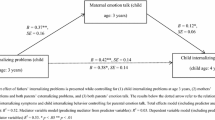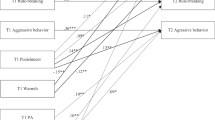Abstract
The purpose of this study was to test relations between parental temperamental emotionality and regulation or related personality characteristics and parental behavior, children's regulation, and children's social functioning. Mothers and fathers reported on their own personality and/or temperament and expressivity in the family (mothers only); parents and teachers rated children (71 girls and 99 boys; M age = 73 months) on their temperamental regulation, social competence, and problem behavior. Mothers also were observed interacting with their child, and behavioral measures of children's regulation were obtained. In general, high parental regulation and low negative emotionality were associated with positive developmental outcomes in children and more positive parental behaviors, and mothers' expression of positive emotion in the family mediated some of the relations of their dispositions to children's socioemotional functioning.
Similar content being viewed by others
REFERENCES
Achenbach, T. M. (1991a). Integrative guide for the 1991 CBCL/4-18, YSR, and TRF profiles. Burlington: University of Vermont, Department of Psychiatry.
Achenbach, T. M. (1991b). Manual for the child behavior checklist/4-18 and 1991 profile. Burlington: University of Vermont, Department of Psychology.
Ahadi, S. A., & Rothbart, M. K. (1994). Temperament, development, and the big five. In C. F. Halverson Jr., G. A. Kohnstamm, & R. P. Martin, (Eds.), The developing structure of temperament and personality from infancy to adulthood (pp. 189-207). Hillsdale, NJ: Erlbaum.
Almagor, M., Tellegen, A., & Waller, N. G. (1995). The big seven model: A cross-cultural replication and further exploration of the basic dimensions of natural language trait descriptors. Journal of Personality and Social Psychology, 69, 300-307.
Belsky, J. (1984). The determinants of parenting: A process model. Child Development, 55, 83-96.
Belsky, J., Crnic, K., & Woodworth, S. (1995). Personal and parenting: Exploring the mediating role of transient mood and daily hassles. Journal of Personality, 60, 253-293.
Borkenau, P., Riemann, R., Angleitner, A., & Spinath, F. M. (2001). Genetic and environmental influences on observed personality: Evidence from the German observational study of adult twins. Journal of Personality and Social Psychology, 80, 655-668.
Brody, G. H., & Ge, X. (2001). Linking parenting processes and self-regulation to psychological functioning and alcohol use during early adolescence. Journal of Family Psychology, 15, 82-94.
Brook, J. S., Richter, L., & Whiteman, M. (2000). Effects of parent personality, upbringing, and marijuana use on the parent-child attachment relationship. Journal of the American Academy of Child and Adolescent Psychiatry, 39, 240-248.
Brook, J. S., Whiteman, M., Balka, E. B., & Cohen, P. (1995). Parent drug use, parent personality, and parenting. Journal of Genetic Psychology, 156, 137-151.
Caspi, A. (1998). Personality development across the life course. In W. Damon (Series Ed.) & N. Eisenberg (Vol. Ed.), Social, emotional, and personality development: Vol. 3. Handbook of child psychology (pp. 311-388). New York: Wiley.
Clark, A. L., Kochanska, G., & Ready, R. (2000). Mothers' personality and its interaction with child temperament as predictors of parenting behavior. Journal of Personality and Social Psychology, 79, 274-285.
Coie, J. D., & Dodge, K. A. (1998). Aggression and antisocial behavior. In W. Damon (Series Ed.) & N. Eisenberg (Vol. Ed.), Handbook of Child Psychology. Vol. 3. Social, emotional, and personality development (pp. 779-862). New York: Wiley.
Cole, P. M. (1986). Children's spontaneous control of facial expression. Child Development, 57, 1309-1321.
Cumberland, A. J., Eisenberg, N., & Reiser, M. (in press). Relations of young children's agreeableness and resiliency to effortful control, impulsivity, and social competence. Social Development.
Davies, P. T., & Cummings, E. M. (1994). Marital conflict and child adjustment: An emotional security hypothesis. Psychological Bulletin, 116, 387-411.
Derryberry, D., & Rothbart, M. K. (1988). Arousal, affect, and attention as components of temperament. Journal of Personality and Social Psychology, 55, 958-966.
Diener, M. L., Goldstein, L. H., & Mangelsdorf, S. C. (1995). The role of prenatal expectations in parents' reports of infant temperament. Merrill-Palmer Quarterly, 41, 172-190.
Downey, G., & Coyne, J. C. (1990). Children of depressed parents: An integrative review. Psychological Bulletin, 108, 50-76.
Dunn, J., Bretherton, I., & Munn, P. (1987). Conversations about feeling states between mothers and their young children. Developmental Psychology, 23, 132-139.
Eisenberg, N., Cumberland, A., Spinrad, T. L., Fabes, R. A., Shepard, S. A., Reiser, M., et al. (2001). The relations of regulation and emotionality to children's externalizing and internalizing problem behavior. Child Development, 72, 1112-1134.
Eisenberg, N., Fabes, R. A., Guthrie, I. K., & Reiser, M. (2000). Dispositional emotionality and regulation: Their role in predicting quality of social functioning. Journal of Personality and Social Psychology, 78, 136-157.
Eisenberg, N., Fabes, R. A., Karbon, M., Murphy, B. C., Wosinski, M., Polazzi, L., et al. (1996). The relations of children's dispositional prosocial behavior to emotionality, regulation, and social functioning. Child Development, 67, 974-992.
Eisenberg, N., Gershoff, E. T., Fabes, R. A., Shepard, S. A., Cumberland, A. J., Losoya, S. H., et al. (2001). Mothers' emotional expressivity and children's behavior problems and social competence: Mediation through children's regulation. Developmental Psychology, 37, 475-490.
Eisenberg, N., Guthrie, I. K., Fabes, R. A., Reiser, M., Murphy, B. C., Holgren, R., et al. (1997). The relations of regulation and emotionality to resiliency and competent social functioning in elementary school children. Child Development, 68, 295-311.
Eisenberg, N., & Morris, A. S. (2002). Children's emotion-related regulation. In R. Kail (Ed.), Advances in child development and behavior (Vol. 30, pp. 190-229). San Diego, CA: Amsterdam.
Fish, M., & Stifter, C. A. (1993). Mother parity as a main and moderating influence on early mother-infant interaction. Journal of Applied Developmental Psychology, 14, 557-572.
Goldstein, L. H., Diener, M. L., & Mangelsdorf, S. C. (1996). Maternal characteristics and social support across the transition to motherhood: Associations with maternal behavior. Journal of Family Psychology, 10, 60-71.
Halberstadt, A. G., Cassidy, J., Stifter, C. A., Parke, R. D., & Fox, N. A. (1995). Self-expressiveness within the family context: Psychometric support for a new measure. Psychological Assessment, 7, 93-103.
Havill, V. L., Besevegis, E., & Mouroussaki, S. (1998). Agreeableness as a diachronic human trait. In G. A. Kohnstamm, C. F. Halverson Jr., I. Mervielde, & V. L. Havill (Eds.), Parental descriptions of child personality: Developmental antecedents of the Big Five (pp. 49-64). Mahwah, NJ: Laurence Erlbaum Associates.
Jang, K. L., Livesley, W. J., Riemann, R., Vernon, P. A., Hu, S., Angleitner, A., et al., (2001). Covariance structure of neuroticism and agreeableness: A twin and molecular genetic analysis of the role of the serotonin transporter gene. Journal of Personality and Social Psychology, 81, 295-304.
John, O. P. (1990). The “Big Five” factor taxonomy: Dimensions of personality in the natural language and in questionnaires. In L. Pervin (Ed.), Handbook of personality: Theory and research (pp. 66-100). New York: Guilford Press.
John, O. P., Donahue, E. M., & Kentle, R. (1991). The “Big Five” Inventory—Versions 4a and 5a (Tech. Rep.) Berkeley: University of California, Institute of Personality and Social Psychology.
Katigbak, M. S., Church, A. T., & Akamine, T. X. (1996). Cross cultural generalizability of personality dimensions relating to indigenous and imported dimensions in two cultures. Journal of Personality and Social Psychology, 70, 99-114.
Kendler, K. S., Sham, P., & McLean, C. J. (1997). The dimensions of parenting: An epidemiological, multi-informant, retrospective study. Psychological Medicine, 27, 549-563.
Kochanska, G., Clark, L. A., & Goldman, M. S. (1997). Implications of mothers' personality for their parenting and their young children's development outcomes. Journal of Personality, 65, 387-420.
Kopp, C. B., & Neufeld, S. J. (2003). Emotional development during infancy. In R. Davidson, K. Scherer, & H. H. Goldsmith (Eds.), Handbook of affective sciences. Oxford, UK: Oxford University Press.
Lengua, L. J., West, S. G., & Sandler, I. N. (1998). Temperament as a predictor of symptomatology in children: Addressing contamination of measures. Child Development, 69, 164-181.
MacKinnon, D. P. (1994). Analysis of mediating variables in prevention and intervention research. In A. Cazares & L. A. Beatty (Eds.), Scientific methods for prevention intervention research. (pp. 127-153) NIDA Research Monograph 139. (DHHS Pub. No. 94-3631). Washington, DC: Supt. of Docs., U.S. Government Printing Office.
MacKinnon, D. P., Lockwood, C. M., Hoffman, J. M., West, S. G., & Sheets, V. (2002). A comparison of methods to test mediation and other intervening variables. Psychological Methods, 7, 83-104.
Mangelsdorf, S., Gunnar, M., Kestenbaum, R., Lang, S., & Andreas, D. (1990). Infant proneness-to-distress temperament, maternal personality, and mother-infant attachment: Associations and goodness of fit. Child Development, 61, 820-831.
Matheny, A. P., Jr., Wilson, R. S., & Thoben, A. S. (1987). Home and mother: Relations with infant temperament. Developmental Psychology, 23, 323-331.
Mebert, C. J. (1991). Dimensions of subjectivity in parents' ratings of infant temperament. Child Development, 62, 352-361.
Nigg, J. T., & Hinshaw, S. P. (1998). Parent personality traits and psychopathology associated with antisocial behaviors in childhood attention-deficit hyperactivity disorder. Journal of Child Psychology and Psychiatry, 39, 145-159.
Plomin, R., & Stocker, C. (1989). Behavioral genetics and emotionality. In J. S. Reznick (Ed.), Perspectives on behavioral inhibition (pp. 219-240). Chicago: Chicago University Press.
Radke-Yarrow, M., & Klimes-Dougan, B. (2002). Parental depression and offspring disorders: A developmental perspective. In. S. H. Goodman & I. H. Gotlib (Eds.), Children of depressed parents: Mechanisms of risk and implications for treatment (pp. 155-173).
Rothbart, M. K., Ahadi, S. A., Hershey, K., & Fisher, P. (2001). Investigations of temperament at 3-7 years: The Children's Behavior Questionnaire. Child Development, 72, 1394-1408.
Rothbart, M. K., & Bates, J. E. (1998). Temperament. In W. Damon (Series Ed.) & N. Eisenberg (Vol. Ed.), Handbook of Child Psychology: Vol. 3. Social, emotional, and personality development (pp. 105-176). New York: Wiley.
Rothbaum, F., & Weisz, J. R. (1994). Parental caregiving and child externalizing behavior in nonclinical samples: A meta-analysis. Psychological Bulletin, 116, 55-74.
Rubin, K. H., Bukowski, W., & Parker, J. G. (1998). Peer interactions, relationships, and groups. In W. Damon (Series Ed.), & N. Eisenberg (Vol. Ed.), Handbook of child psychology: Vol. 3. Social, emotional, and personality development (pp. 619-700). New York: Wiley.
Rubin, K. H., Hastings, P., Chen, X., Stewart, S., & McNichol, K. (1998). Intrapersonal and maternal correlates of aggression, conflict, and externalizing problems in toddlers. Child Development, 69, 1614-1629.
Saudino, K. J., McGuire, S., Reiss, D., Hetherington, E. M., & Plomin, R. (1995). Parent ratings of EAS temperament in twins, full siblings, half siblings, and step siblings. Journal of Personality and Social Psychology, 68, 723-733.
Scaramella, L. V., Conger, R. D., & Simons, R. L. (1999). Parental protective influences and gender-specific increases in adolescent internalizing and externalizing problems. Journal of Research on Adolescence, 9, 111-141.
Solomon, M. (2000). The fruits of their labors: A longitudinal exploration of parent personality and adjustment in their adult children. Journal of Personality, 68, 281-308.
Steinberg, L., & Silk, J. (2002). Parenting adolescents. In M. H. Borstein (Ed.), Handbook of parenting: Vol. 1. Children and parenting (pp. 103-133). Hillsdale, NJ: Erlbaum.
Tellegen, A., & Waller, N. G. (in press). Exploring personality through test construction: Development of the Multidimensional Personality Questionnaire. In S. R. Briggs & J. M. Cheek (Eds.), Personality measures: Development and evaluation (Vol. 1). Greenwich, CT: JAI Press.
Tobin, R. M., Graziano, W. G., Vanman, E. J., & Tassinary, L. G. (2000). Personality, emotional experience, and efforts to control emotions. Journal of Personality and Social Psychology, 79, 656-669.
Trierweiler, L. I., Eid, M., & Lischetzke, T. (2002). The structure of emotional expressivity: Each emotion counts. Journal of Personality and Social Psychology, 82, 1023-1040.
Vaughn, B. E., Deinard, A., & Egeland, B. (1980). Measuring temperament in pediatric practice. Journal of Pediatrics, 96, 510-518.
Vaughn, B. E., Bradley, C. F., Joffe, L. S., Seifer, R., & Barglow, P. (1987). Maternal characteristics measured prenatally are predictive of ratings temperamental “difficulty” on the Carey Infant Temperament Questionnaire. Developmental Psychology, 23, 152-161.
Author information
Authors and Affiliations
Rights and permissions
About this article
Cite this article
Cumberland-Li, A., Eisenberg, N., Champion, C. et al. The Relation of Parental Emotionality and Related Dispositional Traits to Parental Expression of Emotion and Children's Social Functioning. Motivation and Emotion 27, 27–56 (2003). https://doi.org/10.1023/A:1023674308969
Issue Date:
DOI: https://doi.org/10.1023/A:1023674308969




